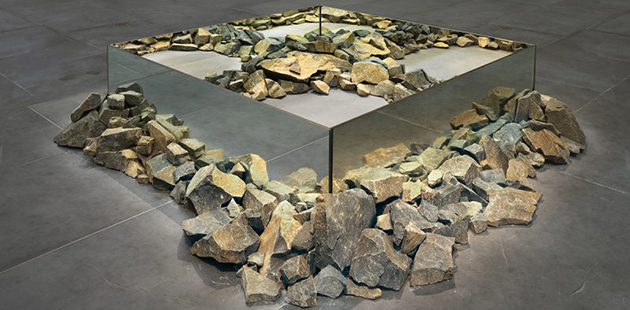 The first exhibition in Australia dedicated to the work of American artist Robert Smithson (1938–1973), Monash University Museum of Art | MUMA presents Robert Smithson: Time Crystals on display from 21 July 2018.
The first exhibition in Australia dedicated to the work of American artist Robert Smithson (1938–1973), Monash University Museum of Art | MUMA presents Robert Smithson: Time Crystals on display from 21 July 2018.
Best known for his radical land art of the 1960s and early 1970s, in the years since his untimely death Smithson has come to be recognised as one of the most influential artists of the twentieth century.
Featuring over 80 items, almost all of which have not been previously seen in Australia, Time Crystals brings together key works of sculpture, film, photography, drawing, prints and texts, drawing on loans from major international and Australian institutions.
At the heart of the exhibition are sketches, preparatory drawings, correspondence, photographs and handwritten manuscripts drawn from the largest ever loan from the Robert Smithson and Nancy Holt Papers, held at the Archives of American Art, Smithsonian Institution, Washington DC.
Presented in collaboration with The University of Queensland Art Museum, Time Crystals is co-curated by Dr Amelia Barikin (The University of Queensland) and Professor Chris McAuliffe (Australian National University), the exhibition and its accompanying publication feature new archival research into Smithson’s practice.
“We are delighted to be working with The University of Queensland Art Museum and guest curators Dr Amelia Barikin and Professor Chris McAuliffe,” says MUMA director Charlotte Day. “Not only is it significant to be able to present an exhibition of the remarkable Robert Smithson in Australia but this exhibition has also involved original research into his archives and presents exciting new insights into the artist himself and new interpretations of his practice.”
Dr Barikin says Smithson remains an inspiring artist because of the radical mix of ideas he brought to his work. “Smithson only worked for a very short period of time but his approach to art has been fundamental for the development of contemporary artistic practice.”
“I’m really inspired by his ideas around time, crystallography, science fiction, geography and geology – he crossed all these boundaries and was finding inspiration in absolutely everything that he could,” added Barikin.
Professor McAuliffe points to Smithson’s legacy as an artist who forever shifted the way artists think about making work. “He’s often thought of as one of the key figures in the development of so-called land art, these monumental structures out in the desert.”
But he also explored film, writing and publishing, lecturing, curating and sculpture – he became one of the first artists who understood himself as project-driven and would explore the medium, the location, the language and the method that was most appropriate to a particular project and strategy,” said McAuliffe.
“That’s his legacy – to be a theorist and writer as well as an artist, to be an artist who would make a film if that was the right way to pursue a project – these are now typical ways of working for today’s artists.”
Smithson’s artistic approach is borne out in the exhibition’s materials, Barikin notes. “Smithson was a prolific writer and an avid collector of visual material, with many of the items in his collection serving as source material for his projects. A distinctive aspect of the exhibition will be its juxtaposition of key artworks with rarely seen archival material,” she says.
“As the most expansive presentation of Smithson’s personal papers ever to be publicly exhibited, including a number of important unpublished writings, the exhibition will offer an extraordinary insight into the artist’s methods, processes, connections and influences.”
The exhibition title, Time Crystals, reflects Smithson’s imaginative approach to temporality, says McAuliffe. “Smithson was inspired by ideas of crystalline geometry and non-biological time. He used the term ‘Time Crystal’ as a metaphor for endlessness, and as a visualisation of static, frozen time,” he says.
“Smithson’s extensive collection of archival material will provide a vehicle for us to explore these ideas and how they shaped an art practice that redefined abstraction and challenged art history.”
Robert Smithson: Time Crystals will be accompanied by a program of public events, including a half-day symposium, Robert Smithson: A Crystalline World on Saturday 25 August, and a three-part film program curated by John Edmond on Wednesdays: 22 August, 5 September and 19 September 2018.
Robert Smithson: Time Crystals
Monash University Museum of Art | MUMA, 900 Dandenong Road, Caulfield East
Exhibition: 21 July – 22 September 2018
Free entry
For more information, visit: www.monash.edu for details.
Image: Robert Smithson, Rocks and Mirror Square II 1971, basalt rocks and mirrors 36 x 220 x 220 cm irregular. Collection: National Gallery of Australia, Canberra Purchased 1977 © Holt-Smithson Foundation/VAGA. Licensed by Viscopy, 2017
